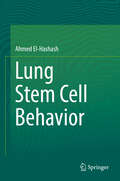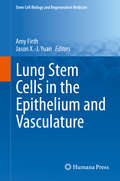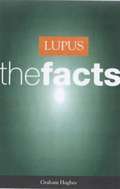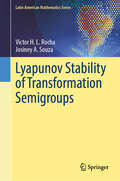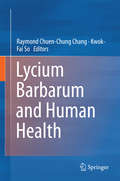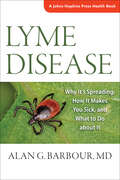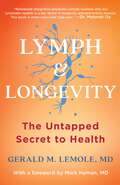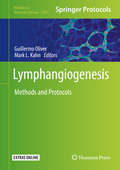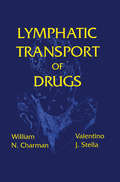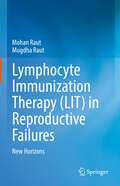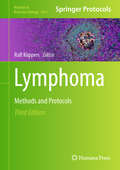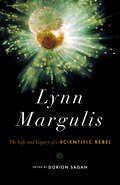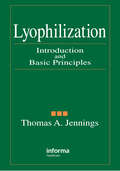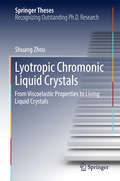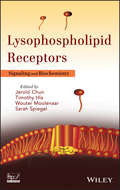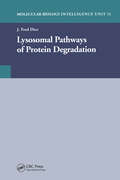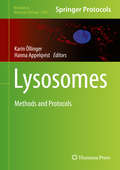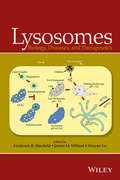- Table View
- List View
Lung Stem Cell Behavior
by Ahmed El-HashashThis book reviews stem cell behavior in the lung as it relates to regenerative medicine and stem cell therapeutics. Topics ranging from basic developmental mechanisms of various types of lung stem cells through the identification and properties of stem cell behavior and their potential applications in lung repair and regeneration, are discussed by an expert in the field. These discoveries are placed within the structural context of tissue and developmental biology in sections dealing with recent advances in understanding of developmental lung stem cell biology and behavior and their potential applications. Lung Stem Cell Behavior is essential reading for researchers in stem cell biology and regenerative medicine, patient advocates, undergraduate students, graduate students, and clinicians interested in cellular therapy and tissue engineering therapies.
Lung Stem Cells in the Epithelium and Vasculature
by Amy Firth Jason X.-J. YuanThis book covers the identification and role of endogenous lung stem cells in health and disease, particularly the most recent advances. In addition, it discusses the rapidly growing field of stem cells and cell therapy as it relates to lung biology and disease as well as ex vivo lung bioengineering. Such approaches may provide novel therapeutic approaches for lung diseases. Human pluripotent stem cell differentiation to model the pulmonary epithelium and vasculature is also discussed. World-recognized scientists who specialize in studying both the lung epithelium and pulmonary vasculature contribute the chapters. Topics covered include: stem cell niches in the lung, the role of progenitor cells in fibrosis and asthma, iPSC in modeling lung disease, vascular repair by endothelial progenitor cells and circulating fibrocytes in pulmonary vascular remodeling. This volume of the Stem Cell Biology and Regenerative Medicine series is essential reading for researchers and clinicians interested in stem cells, lung biology and regenerative medicine. It is also an invaluable resource for advanced students studying cell biology, regenerative medicine and lung physiology.
Lung Surfactants: Basic Science and Clinical Applications (Lung Biology in Health and Disease)
by Knud Erik SkoubyIntegrating basic and clinical research on the biophysical and physiological functions of pulmonary surfactants, this practical reference presents thorough, cutting-edge coverage on surfactant-related lung disease. Manage neonatal respiratory distress syndrome (RDS), acute respiratory distress syndrome (ARDS), and acute lung injury more effecti
Lupus The Facts
by Graham HughesThis easy-to-read book explains Lupus. How does Lupus affect people? What can be done if someone develops lupus?
Lust und Liebe - alles nur Chemie? (Erlebnis Wissenschaft)
by Rolf Froböse Gabriele FroböseHinter dem Titel des Bandes verbirgt sich mehr als bloß die Analyse von Aphrodisiaka oder Potenzmitteln. Großhirnrinde, Hypophyse oder körpereigene Opiate: Sie alle sind beteiligt, wenn Verliebte sich küssen oder ein junger Mann seinem ersten Rendezvous entgegenfiebert. Dieses unterhaltsame Buch wirft einen Blick hinter die molekularen Kulissen des aufregendsten aller Gefühle. Die Liebe schlägt nicht nur Verliebte in ihren Bann. Dass auch Chemiker manch faszinierende Erkenntnis zu diesem Phänomen vermitteln können, belegt dieses Buch eindrucksvoll. Ihren wissenschaftlichen Streifzug durch Amors Reich beginnt das Autorenduo (das übrigens auch ein Autorenpaar ist) mit einer Geschichte: Zwei Verliebte treffen sich wieder, nachdem sie sich eine Weile nicht gesehen haben. Was geschieht in ihren Köpfen? Wie lassen sich ihre Verhaltensweisen und Reaktionen chemisch beschreiben? Im Anschluss widmen sich die beiden Wissenschaftsjournalisten ausführlich der "Mentalität" der Liebe: Sie gehen der Frage nach, wie sie im menschlichen Gehirn repräsentiert wird. Auch den "Dialog der Düfte" entschlüsseln sie und fragen nach den physiologischen Hintergründen von Zärtlichkeit und Treue. Sie erklären, wie Moleküle unsere Emotionen steuern, und belegen, dass sich Verliebte wirklich gut "riechen" können. Nicht nur Chemiker dürfte interessieren, was das Buch über die "Wirkstoffe der Liebe" zu berichten weiß. Mal ergründet es die Funktionsweise körpereigener Opiate, dann wenden sich die Autoren den Aphrodisiaka zu oder referieren den Stand der Dinge in Sachen Potenzmittel. Die Fortsetzung der kleinen Liebesgeschichte vom Anfang sowie ein Sach- und Personenregister beschließen den Band.
Lyapunov Functionals and Stability of Stochastic Functional Differential Equations
by Leonid ShaikhetStability conditions for functional differential equations can be obtained using Lyapunov functionals. Lyapunov Functionals and Stability of Stochastic Functional Differential Equations describes the general method of construction of Lyapunov functionals to investigate the stability of differential equations with delays. This work continues and complements the author's previous book Lyapunov Functionals and Stability of Stochastic Difference Equations, where this method is described for difference equations with discrete and continuous time. The text begins with both a description and a delineation of the peculiarities of deterministic and stochastic functional differential equations. There follows basic definitions for stability theory of stochastic hereditary systems, and the formal procedure of Lyapunov functionals construction is presented. Stability investigation is conducted for stochastic linear and nonlinear differential equations with constant and distributed delays. The proposed method is used for stability investigation of different mathematical models such as: * inverted controlled pendulum; * Nicholson's blowflies equation; * predator-prey relationships; * epidemic development; and * mathematical models that describe human behaviours related to addictions and obesity. Lyapunov Functionals and Stability of Stochastic Functional Differential Equations is primarily addressed to experts in stability theory but will also be of interest to professionals and students in pure and computational mathematics, physics, engineering, medicine, and biology.
Lyapunov Stability of Transformation Semigroups (Latin American Mathematics Series)
by Victor H. Rocha Josiney A. SouzaThis book presents recent research results on Lyapunov stability and attraction for semigroup actions in a pedagogical format, providing the reader with numerous modern ideas and mathematical formulations for dynamical concepts in the transformation group theory. In recent decades, many fundamental concepts of dynamical systems have been extended to the general framework of transformation semigroups. Limit sets, attractors, isolated invariant sets, prolongational limit sets, and stable sets now have semigroup theoretical analogues. This monograph consolidates recent advancements in this field in a way that makes it accessible to graduate students. An effort was made to relate the presented results to important recurrence notions, for contextual clarity. A rudimentary understanding of group theory and topology, including the concepts of semigroup action, orbit, fiber bundle, compactness, and connectedness, is a prerequisite for reading this text. As a valuable resource for research projects and academic dissertations on topological dynamics, geometry, and mathematical analysis, this work can potentially open new avenues for further research.
Lycium Barbarum and Human Health
by Raymond Chuen-Chung Chang Kwok-Fai SoThis book seeks to unravel the mysteries of wolfberry, and systematically introduces its mechanisms in preventing aging-associated diseases, such as cardiovascular diseases, inflammation, liver and neurodegenerative diseases. Wolfberry, the dried fruit of Lycium barbarum, is an anti-aging herbal medicine. There have been numerous reports investigating the underlying mechanisms of its anti-aging effects and its role in preventing pathological changes in many aging-associated diseases. Its holistic effects on the body can attenuate liver toxicity and combat the spread of cancer; it also prevents degeneration in the central nervous system, and can even positively affect the skin. As such, wolfberry has become a very popular food supplement around the world. This book will serve as an excellent reference source for researchers and graduate students studying herbal medicine and aging-associated diseases, while also providing insights for the pharmaceutical industry with regard to developing potential drugs for these diseases.
Lycopene: Nutritional, Medicinal and Therapeutic Properties
by Victor R. Preedy Ronald R. WatsonTomatoes have become a dietary staple for humans in many parts of the world. The characteristic deep red color of the ripe tomato fruit and related products is mainly due to lycopene. Lycopene is the predominant carotenoid in tomatoes, followed by a-carotene, b-carotene, g-carotene, and phytoene, as well as by several other minor carotenoids. Tomat
Lyman-alpha as an Astrophysical and Cosmological Tool: Saas-Fee Advanced Course 46. Swiss Society for Astrophysics and Astronomy (Saas-Fee Advanced Course #46)
by Matthew Hayes Mark Dijkstra J. Xavier Prochaska Masami OuchiThe hydrogen Lyman-alpha line is of utmost importance to many fields of astrophysics. This UV line being conveniently redshifted with distance to the visible and even near infrared wavelength ranges, it is observable from the ground, and provides the main observational window on the formation and evolution of high redshift galaxies. Absorbing systems that would otherwise go unnoticed are revealed through the Lyman-alpha forest, Lyman-limit, and damped Lyman-alpha systems, tracing the distribution of baryonic matter on large scales, and its chemical enrichment.We are living an exciting epoch with the advent of new instruments and facilities, on board of satellites and on the ground. Wide field and very sensitive integral field spectrographs are becoming available on the ground, such as MUSE at the ESO VLT. The giant E-ELT and TMT telescopes will foster a quantum leap in sensitivity and both spatial and spectroscopic resolution, to the point of being able, perhaps, to measure directly the acceleration of the Hubble flow. In space, the JWST will open new possibilities to study the Lyman-alpha emission of primordial galaxies in the near infrared. As long as the Hubble Space Telescope will remain available, the UV-restframe properties of nearby galaxies will be accessible to our knowledge. Therefore, this Saas-Fee course appears very timely and should meet the interest of many young researchers.
Lyme Disease: Why It’s Spreading, How It Makes You Sick, and What to Do about It (A Johns Hopkins Press Health Book)
by Alan G. BarbourA world-renowned Lyme disease expert explains everything you need to know if you live, work, or play in areas with the ticks that carry disease.Once restricted to small forested areas in the northeast and north-central United States, Lyme disease is now a common infection in North America and Europe. The Centers for Disease Control and Prevention estimate that more than 300,000 new cases occur each year in the United States. Misunderstandings over symptoms and treatment increase the public's concerns about the disease—which, if not properly treated, can become chronic and debilitating. An expert on tick-borne diseases, Alan G. Barbour explains the course of illness that results from infection, diagnosis and treatment options, and steps that can be taken to avoid a tick bite in the first place. The ticks that transmit Lyme disease may also transmit other disease-causing pathogens, and these other infections are considered as well. Drawing on real case histories of individuals with Lyme disease—or illnesses that may be mistaken for Lyme disease—Barbour explains: The biology of the spirochete, Borrelia burgdorferi, that causes Lyme disease The role of animals such as mice that carry the infection The life cycle of the ticks that transmit the infection The importance of deer in perpetuating the cycle The basics of diagnostic laboratory tests and how test results are interpreted How antibiotics are used in treating Lyme diseaseInfected ticks are abundant in the woods, in walking trails, and in the shrubs and tall grass where suburban lawns meet wooded areas. Barbour stresses preventing disease through community-wide ecology projects and individual and household protection. While it may be difficult to escape infection, understanding the danger, the symptoms, and the treatment goes a long way toward preventing long-term health consequences. Featuring a list of reliable web sites and a glossary of terms, Lyme Disease is an invaluable resource for everyone who is at risk of the disease or is involved in preventing and treating it.
Lymph & Longevity: The Untapped Secret to Health
by M.D. Gerald LemoleLearn how you can boost your immune system and help prevent virtually every major medical condition—including cancer, heart disease, neurological disorders, GI issues, and obesity—by keeping your lymph system healthy, as explained by renowned cardiologist Gerald Lemole.The lymphatic system serves as our body&’s maintenance department and has a direct effect on our cardiovascular, neurological, and immune systems. It has also been one of the most misunderstood systems. Until now. At last, renowned cardiothoracic surgeon and pioneer in the study of lymph Gerald Lemole explains in straightforward language why the lymphatic system is the key factor in longevity and disease prevention, and how improving lymphatic flow can help our bodies eliminate the toxins and waste products that contribute to injury, inflammation, and disease. In ten short chapters he demystifies the lymphatic system, describes how powerful it is, and shows how to maintain a healthy lymph system to combat specific diseases and health problems—from heart disease to cognitive function to weight management. Featuring sidebars with charts and graphs that illustrate basic principles, Lymph & Longevity also includes flow-friendly menus, recipes, and information on supplements, as well as basic yoga and meditation guides. Illuminating, informative, and practical this essential guide is more timely now than ever as we continue to work to protect ourselves and our communities against Covid-19 and other viruses.
Lymphangiogenesis: Methods and Protocols (Methods in Molecular Biology #1846)
by Guillermo Oliver Mark L. KahnThis volume discusses the latest tools, techniques, and animal models designed to study the processes of lymphatic vascular formation in vivo and in vitro and its functions in health and disease. The chapters in the book cover topics such as genetics lineage tracing of lymphatic endothelial cells in mice; characterization of zebrafish facial lymphatics; imaging lymphatics in mouse lungs; effects of fluid shear stress of lymphatic endothelial cells; and single cell mRNA sequencing of the mouse brain vasculature. Written in the highly successful Methods in Molecular Biology series format, chapters include introductions to their respective topics, lists of the necessary materials and reagents, step-by-step, readily reproducible laboratory protocols, and tips on troubleshooting and avoiding known pitfalls.Cutting-edge and comprehensive, Lymphangiogenesis: Methods and Protocols is a valuable resource to aid researchers with applying new approaches to answer their questions in this developing field.
Lymphatic Transport of Drugs
by William N. CharmanLymphatic Transport of Drugs provides a thorough review of the determinants that affect the uptake and delivery of drugs and xenobiotics to the lymphatics. Factors affecting the transport and delivery of lipophilic drugs through the lymph after oral administration, lymphatic transport of polar drugs and macromolecules after gastrointestinal dosing, transport of drugs into the lymph after parenteral administration, and particulate drug delivery systems are among the topics examined in this volume. Lymphatic Transport of Drugs is primarily intended for pharmaceutical scientists who are attempting to alter the delivery of current therapeutic agents through formulation of prodrugs, as well as for researchers designing new drugs for lymph delivery.
Lymphocyte Immunization Therapy (LIT) in Reproductive Failures: New Horizons
by Mohan Raut Mugdha RautRecurrent Miscarriages (RM) & Implantation Failure (IF) have remained an enigma to clinicians and researchers. Even after ruling out all possible causative factors, 50-60% cases still remain “Unexplained’. A majority of these so called “Unexplained” cases are now found to have immunological basis.This book is going into the Immunological aspects of these clinical dilemmas, demystifying the role of Immunology and Immunotherapy in RM and IF. The authors have been working in the field of Reproductive Immunology and Immunotherapy for the last 25 years and they have come out with this book combining the international studies with their own experience. The purpose of writing this book is to provide a comprehensive treatise about Immunotherapy, so that it can become an acceptable modality of treatment in cases where it is needed and is effective.The book discusses the basics in Reproductive Immunology. The immunological changes occurring during pregnancy, the role of Cell mediated Immunity (T cells), Humoral Immunity including cytokines is explained. The normal immunological mechanisms protecting the embryo are highlighted and how these mechanisms are disturbed leading to RM and IF, is also explained.The first and the most discussed method of Immunotherapy is Lymphocyte Immunization Therapy (LIT). The book has given a complete overview of LIT, describing how it created euphoria when it was first introduced, how it gradually went into disrepute and how it is now making a comeback. As the authors have personal experience of LIT, the book gives a detailed and complete information about this active form of immunotherapy.The book has a special section on case studies where the authors have given some clinical case reports (including some of their own), who were treated for immunological factor in RM/IF and were treated with Immunotherapy. These cases can be a useful guide to the readers.The book will be useful not only for undergraduate and postgraduate students but also for clinicians in their practice and for researchers for review of developments in the field.
Lymphoma
by Robert Marcus Robert Marcus John W. Sweetenham Michael E. Williams John W. SweetenhamMajor advances have occurred in the diagnosis and treatment of lymphoma in recent years. Our understanding of the molecular biology and genetics of the disease has increased exponentially, and significant imaging developments have resulted in earlier and more accurate diagnosis. The new edition of this landmark text places these advances in the context of daily clinical practice. Each chapter has been updated to reflect recent developments, including new treatment agents such as immunomodulatory drugs and the next generation of antibodies, and the increasing prognostic role of PET scanning. Results from recent large-scale clinical trials are presented, and pathology and cytogenetics are integrated into discussion of each disease entity, enabling the reader to review all the key diagnostic information in one place. Featuring many color illustrations, and written and edited by leading authorities in the field, Lymphoma provides all the information you need to diagnose and manage these complex disorders.
Lymphoma: Methods and Protocols (Methods in Molecular Biology #2865)
by Ralf KüppersThis detailed volume expands upon the previous edition with key methods currently used in lymphoma research, partly specific for lymphoma research but often adaptable to the study of other cancers. New chapters explore the latest approaches for single cell B cell and T cell receptor sequencing, multiplexed immunophenotyping of lymphoma tissue samples, genetic manipulation and extended culture of human germinal center B cells, genetic mouse models of lymphomas, establishment of patient-derived xenograft models of lymphomas, and more. Written in the highly successful Methods in Molecular Biology series format, chapters include introductions to their respective topics, lists of the necessary materials and reagents, step-by-step and readily reproducible laboratory protocols, and tips on troubleshooting and avoiding known pitfalls. Authoritative and up-to-day, Lymphoma: Methods and Protocols, Third Edition serves as a valuable resource for hematologists, hematopathologists, and scientists interested in a variety of topics in cancer research, human genetics, and immunology.
Lynn Margulis: The Life and Legacy of a Scientific Rebel
by Dorion SaganTireless, controversial, and hugely inspirational to those who knew her or encountered her work, Lynn Margulis was a scientist whose intellectual energy and interests knew no bounds. Best known for her work on the origins of eukaryotic cells, the Gaia hypothesis, and symbiogenesis as a driving force in evolution, her work has forever changed the way we understand life on Earth.When Margulis passed away in 2011, she left behind a groundbreaking scientific legacy that spanned decades. In this collection, Dorion Sagan, Margulis's son and longtime collaborator, gathers together the voices of friends and colleagues to remark on her life and legacy, in essays that cover her early collaboration with James Lovelock, her fearless face-off with Richard Dawkins during the so-called "Battle of Balliol" at Oxford, the intrepid application of her scientific mind to the insistence that 9/11 was a false-flag operation, her affinity for Emily Dickinson, and more.Margulis was elected to the National Academy of Sciences in 1983, received the prestigious National Medal of Science in 1999, and her papers are permanently archived at the Library of Congress. Less than a month before her untimely death, Margulis was named one of the twenty most influential scientists alive - one of only two women on this list, which include such scientists as Stephen Hawking, James Watson, and Jane Goodall.&“Although she could be a bulldog, her heart was soft and her spirit loving beneath the scientific realpolitik of her conversation and the insistent tough-mindedness of her sometimes strident and blunt, withering and refreshingly unadorned opinions.&”—Dorion Sagan, from the introduction
Lyophilization: Introduction and Basic Principles
by Thomas A. JenningsFinding consistent, analytical discussions of processes and principles of lyophilization can be challenging and often frustrating. The first resource to gather information about the field, Lyophilization: Introduction and Basic Principles is still the book to have on lyophilization. Presenting information in an easy-to-read style, the book comprehe
Lyotropic Chromonic Liquid Crystals
by Shuang ZhouThis thesis describes lyotropic chromonic liquid crystals (LCLCs) with exotic elastic and viscous properties. The first part of the thesis presents a thorough analysis of the elastic and viscous properties of LCLCs as functions of concentration, temperature and ionic contents, while the second part explores an active nematic system: living liquid crystals, which represent a combination of LCLC and living bacteria. LCLCs are an emerging class of liquid crystals that have shown profound connections to biological systems in two aspects. First, the assembly process of the chromonic aggregates is essentially the same as DNA oligomers and other super-molecular assemblies of biological origin. LCLCs thus provide an excellent model system for studying physical properties such as the elasticity and viscosity of these supramolecular assemblies. Second, LCLCs are biocompatible, thus serving as a unique anisotropic matrix to interface with living systems such as bacteria. This thesis deepens our understanding of both aspects. The noncovalent nature of chromonic aggregation produces the unique viscoelasticity to be found in LCLCs, which differs dramatically from that of traditional LCs. Anisotropic interactions between LCLCs and bacteria lead to fascinating phenomena such as the deformation of LCLCs with a characteristic wavelength determined by the elasticity of the LCLCs and the activity of the bacteria, orientationally controlled trajectories of bacteria and visualization of 24 nm flagella motion.
Lysenko's Ghost: Epigenetics and Russia
by Loren GrahamLysenko became one of the most notorious figures in twentieth-century science after his genetic theories were discredited decades ago. Yet some scientists now claim that discoveries in epigenetics prove that he was right after all. Loren Graham reopens the case, to determine whether new developments in molecular biology validate Lysenko's claims.
Lysophospholipid Receptors
by Wouter Moolenaar Timothy Hla Sarah Spiegel Jerold ChunThe current state of the science supporting new research in lysophospholipidsThe study of lysophospholipids exploded with the discovery of cell surface receptors on both lysophosphatidic acid (LPA) and sphingosine 1-phosphate (S1P). Since then, thousands of original research reports-ranging from fundamental cell signaling to the physiology and pathophysiology of individual organ systems-have centered on lysophospholipids. This book draws together and analyzes the current literature to provide readers with a state-of-the-science review as well as current techniques that support research in all aspects of the field of lysophospholipid signaling.Lysophospholipid Receptors is divided into three sections:Receptors and other possible effectorsEnzymesPhysiology and pathophysiologyWithin each section, the authors explain the similarities and differences between LPA and S1P signaling. Examples are provided that demonstrate the underlying mechanisms of lysophospholipid signaling across a broad range of organ systems, such as S1P signaling in cardiovascular physiology and disease and the neural effects of LPA signaling. Extensive references at the end of each chapter provide a gateway to the literature and facilitate further research into individual topics.Each chapter has been authored by one or more leading international authorities in lysophospholipid research. Based on a thorough analysis of the current research, the authors set forth what is established science and offer their expert opinion and perspective on new and emerging areas of research, setting the stage for further investigations that will solve current problems in the field.
Lysosomal Pathways of Protein Degradation
by J Fred DiceLysosomal Pathways of Protein Degradation looks at cell biology from the view of a lysosome. It summarizes the composition and assembly of lysosomes in mammalian and yeast cells. It also reviews current knowledge about pathways of endocytosis and secretion and how both endocytosed and secreted proteins can be delivered to lysosomes for degradation.
Lysosomes
by Karin Öllinger Hanna AppelqvistThis volume provides laboratory protocols essential for studies on lysosomal biology. Chapters aim to guide researchers in their exploration of lysosomes, both under normal conditions and in pathological processes. Written in the highly successful Methods in Molecular Biology series format, chapters include introductions to their respective topics, lists of the necessary materials and reagents, step-by-step, readily reproducible laboratory protocols, and tips on troubleshooting and avoiding known pitfalls. Authoritative and practical, Lysosome: Methods and Protocols aims to provided protocols that will guide and inspire further research and generate new insights into this fascinating organelle.
Lysosomes: Biology, Diseases, and Therapeutics
by Shuyan Lu James M. Willard Frederick R. MaxfieldDiscussing recent findings, up-to-date research, and novel strategies, the book integrates perspectives from pharmacology, toxicology, and biochemistry to illustrate the potential of lysosomes in drug discovery and development.* Explores basic principles and properties of lysosomes that allow them to act as regulators of cell metabolism, therapeutic targets, and sites for activation of drug conjugates * Discusses the role of lysosomes in metabolism, drug targeting, apoptosis, cancer, aging, inflammation, autophagy, metabolism, toxicity, and membrane repair* Introduces new pathways in therapeutic development and new mechanisms in drug development
